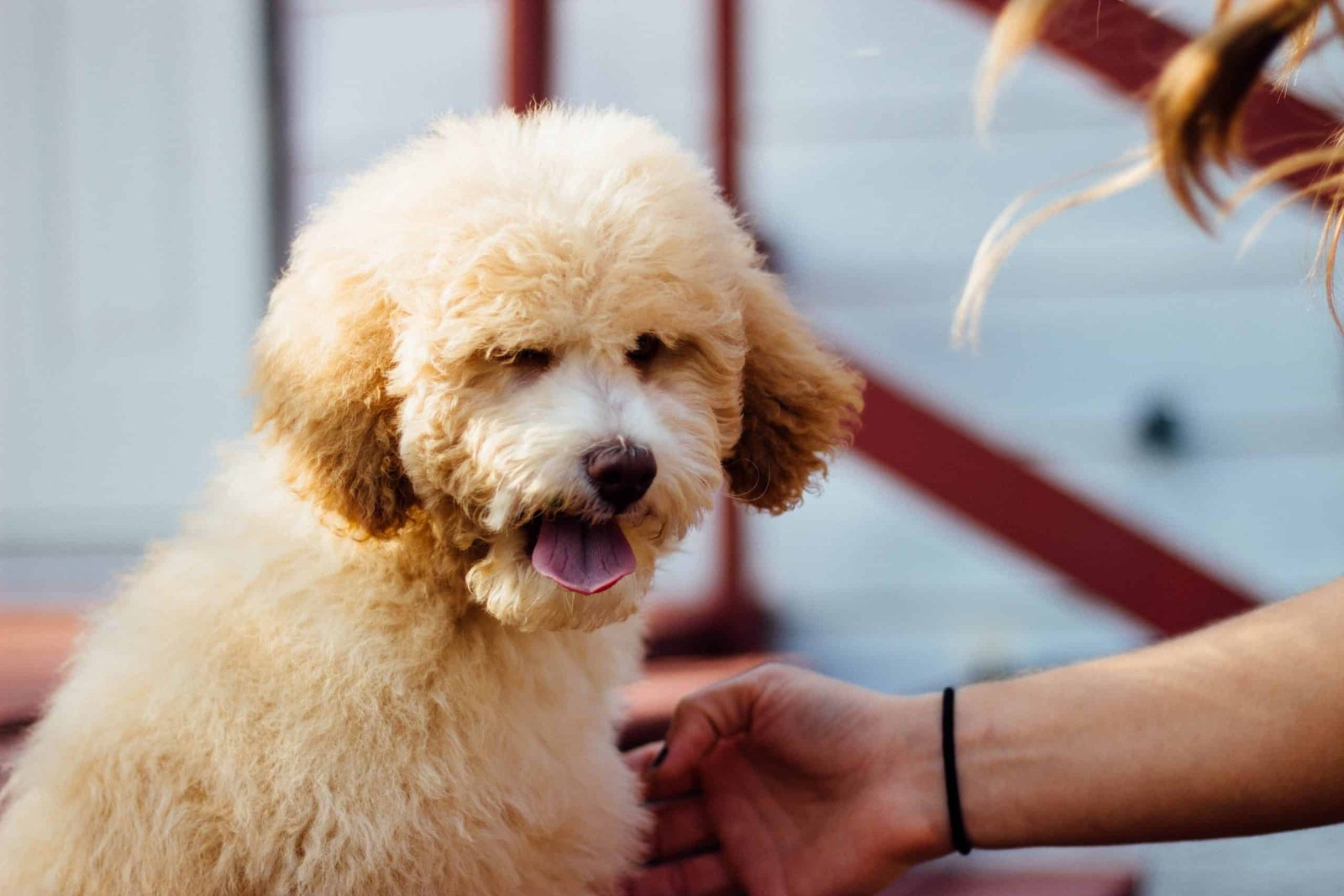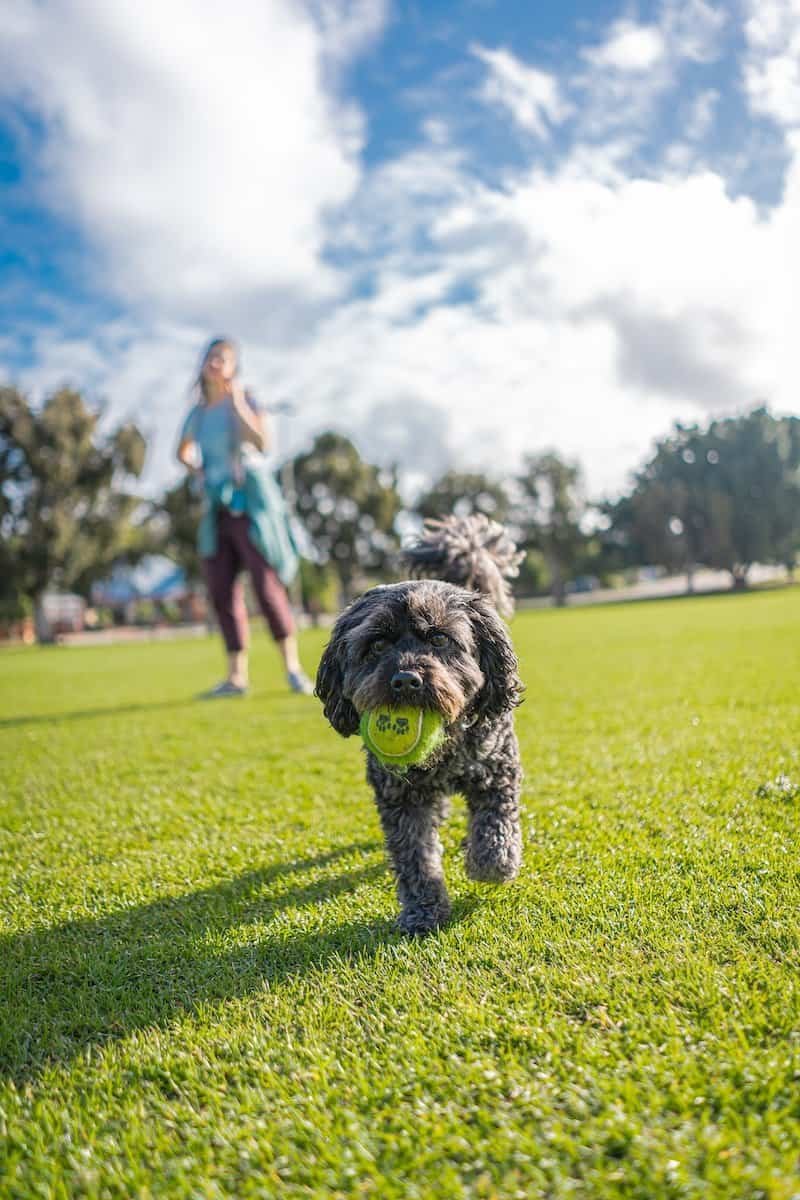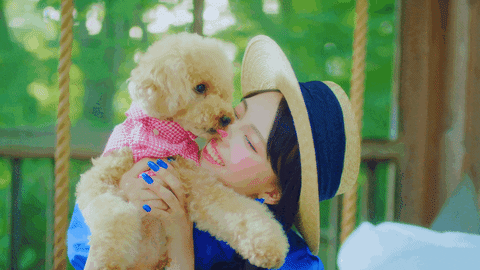Positive reinforcement training is an effective way to teach your poodle new behaviors and reinforce positive ones. This technique involves rewarding your pet for good behavior, such as sitting when commanded, and ignoring or redirecting negative behavior. Positive reinforcement training is a humane and effective way to train your poodle, and it has been shown to be more effective than punishment-based techniques.
Understanding positive reinforcement is key to successful poodle training. Positive reinforcement involves rewarding your poodle for good behavior and ignoring or redirecting negative behavior. This technique is based on the idea that dogs will repeat behaviors that are rewarded, so by rewarding positive behavior, you can encourage your poodle to repeat it. Positive reinforcement can be used to teach your poodle a wide range of behaviors, from basic obedience commands like “sit” and “stay” to more complex tricks like “roll over” and “play dead.”
Key Takeaways
- Positive reinforcement training is an effective and humane way to train your poodle.
- Understanding positive reinforcement is key to successful poodle training.
- Positive reinforcement can be used to teach your poodle a wide range of behaviors.
Understanding Positive Reinforcement
Positive reinforcement is a powerful training technique that involves rewarding desirable behaviors to encourage their repetition. It is a key component of operant conditioning, a method of learning that relies on consequences to shape behavior. Positive reinforcement works by providing a reward, such as a treat or praise, when a dog performs a desired behavior. The reward increases the likelihood that the dog will repeat the behavior in the future.
Positive reinforcement is a more effective training technique than positive punishment or negative punishment. Positive punishment involves adding an unpleasant consequence to discourage an undesirable behavior, while negative punishment involves removing a pleasant consequence to discourage an undesirable behavior. While these techniques can be effective in some situations, they can also have unintended negative consequences, such as fear or aggression.
Positive reinforcement, on the other hand, is a humane and effective way to train dogs. It is based on the principle that behavior that is rewarded is more likely to be repeated. When a dog performs a desired behavior, such as sitting or coming when called, they are rewarded with a treat or praise. Over time, the dog learns that performing the desired behavior leads to a positive outcome, and they are more likely to repeat the behavior in the future.
Positive reinforcement can be used to teach a wide range of behaviors, from basic obedience commands to more complex tricks and behaviors. It is a versatile and flexible training technique that can be used with dogs of all ages and breeds. By using positive reinforcement, you can build a strong bond with your dog based on trust and mutual respect.
In summary, positive reinforcement is a powerful and effective training technique that can help you teach your poodle a wide range of behaviors. By rewarding desirable behaviors, you can encourage your dog to repeat them in the future, building a strong bond based on trust and respect. Positive reinforcement is a humane and effective alternative to punishment-based training techniques, and it can help you build a happy, healthy relationship with your poodle.
The Role of Positive Reinforcement in Dog Training
Positive reinforcement is a training method that involves rewarding good behavior in dogs. The reward could be a treat, a toy, or verbal praise, and it is given immediately after the desired behavior occurs. Positive reinforcement is an effective training technique that can help to shape a dog’s behavior and promote good behavior.
One of the key benefits of positive reinforcement is that it helps to build a strong bond between the dog and the trainer. Dogs are social animals, and they crave attention and affection from their owners. Positive reinforcement provides an opportunity for the trainer to interact with the dog in a positive way, which can help to strengthen the bond between them.
Another benefit of positive reinforcement is that it can help to promote mental exercise in dogs. Dogs are intelligent animals, and they require mental stimulation to stay healthy and happy. Positive reinforcement provides an opportunity for dogs to use their minds and learn new things, which can help to keep them mentally stimulated and engaged.
Positive reinforcement is also an effective way to promote good behavior in dogs. When a dog is rewarded for good behavior, they are more likely to repeat that behavior in the future. This can help to promote good behavior and discourage bad behavior, which can make training easier and more effective.
Overall, positive reinforcement is an important tool in dog training. It can help to build a strong bond between the dog and trainer, promote mental exercise, and promote good behavior. If you are looking to train your dog, consider using positive reinforcement as a training technique. With patience and consistency, you can use positive reinforcement to shape your dog’s behavior and promote good behavior.
Specific Techniques in Positive Reinforcement Training
Positive reinforcement training involves rewarding your poodle for the things they do right. The reward could be a treat, toy, or praise – whatever your dog wants to work for. Positive reinforcement is one of the most effective ways to train your poodle and can help create a strong bond between you and your furry friend.
Treats and Toys
Treats and toys are powerful motivators for poodles. Use them to reward your poodle when they exhibit desirable behavior, such as sitting, staying, or coming when called. To keep your poodle motivated, use a variety of treats and toys and switch them up often.
Clicker Training
Clicker training is a popular technique that involves using a clicker to mark desirable behavior. The sound of the clicker tells your poodle that they have done something right and that a reward is coming. Clicker training can be especially useful when teaching your poodle new tricks.
Verbal Cues
Verbal cues are another important component of positive reinforcement training. Use clear, concise commands when teaching your poodle new behaviors. For example, use the word “sit” when teaching your poodle to sit. Be consistent with your verbal cues, and always use the same command for the same behavior.
Shaping
Shaping is a technique that involves breaking down a behavior into smaller steps. Reward your poodle for each step they take towards the desired behavior. For example, when teaching your poodle to roll over, you might reward them for lying down, then for rolling onto their side, and finally for completing the full roll.
Timing and Consistency
Timing and consistency are critical when using positive reinforcement training. Reward your poodle immediately after they exhibit desirable behavior. Consistency is also essential – always reward your poodle for the same behavior, and always use the same reward.
Rewarding Your Dog
When rewarding your poodle, use a high-value reward. A high-value reward is something that your poodle really wants, such as a piece of chicken or a favorite toy. Using high-value rewards will help keep your poodle motivated and engaged in the training process.
Positive reinforcement training is a powerful tool for training your poodle. By using treats, toys, clicker training, verbal cues, shaping, timing, consistency, and high-value rewards, you can create a strong bond with your furry friend and teach them new behaviors in a fun and effective way.
The Importance of Patience and Consistency
When it comes to poodle training, patience and consistency are two of the most important factors to consider. Poodles are intelligent and sensitive dogs that require a calm and positive environment to learn and thrive. In this section, we will discuss the significance of patience and consistency in poodle training and how they can help you achieve your training goals.
Patience
Patience is a crucial aspect of poodle training. It takes time and effort to teach a poodle new behaviors and commands. Rushing the process or getting frustrated when your poodle doesn’t understand a command can lead to negative associations with training and hinder progress. It’s essential to keep in mind that every dog learns at its own pace, and some may take longer than others to grasp a concept.
To cultivate patience during poodle training, it’s important to set realistic goals and have a positive attitude. Celebrate small successes and progress, and don’t get discouraged by setbacks. Focus on building a strong bond with your poodle and creating a positive training environment. By doing so, you’ll establish trust and encourage your poodle to learn and grow.
Consistency
Consistency is another critical factor in poodle training. Poodles thrive on routine and structure, and inconsistency can confuse and frustrate them. It’s essential to establish clear rules and boundaries and to stick to them consistently. This includes using the same commands and cues and rewarding good behavior every time.
Consistency also means ensuring that everyone in the household is on the same page when it comes to poodle training. If one family member uses a different command or allows the poodle to engage in behavior that’s not allowed, it can confuse and hinder progress. Consistency across the board will help your poodle understand what’s expected of them and make training more effective.
In addition to being patient and consistent, it’s crucial to maintain focus during poodle training. Avoid distractions and create a positive training environment that’s free of negative stimuli. By doing so, you’ll set your poodle up for success and make training a positive and enjoyable experience for both you and your furry friend.
Overall, patience and consistency are key to successful poodle training. By being patient and consistent and maintaining focus, you’ll create a positive training environment that encourages learning and growth. With time and effort, your poodle will develop good habits and behaviors that will last a lifetime.
Addressing Negative Behaviors Positively
Positive reinforcement is a powerful tool in poodle training, but it’s important to address negative behaviors in a positive way as well. Punishment and negative reinforcement can be harmful to your poodle’s mental and emotional well-being, and can even make problem behaviors worse. Instead, focus on positively reinforcing good behaviors and redirecting negative behaviors in a positive way.
Reducing Barking
Barking is a common problem behavior in poodles, but it can be addressed without resorting to punishment. Instead of scolding your poodle for barking, try positively reinforcing quiet behavior. When your poodle is quiet, reward them with treats, praise, and attention. You can also redirect their attention to a toy or other activity to distract them from barking.
Addressing Excessive Barking
If your poodle is barking excessively, it’s important to address the underlying cause of the behavior. This could be boredom, anxiety, or a need for attention. Instead of punishing your poodle for barking, try to address the root cause of the behavior. Provide plenty of mental and physical stimulation, such as puzzle toys and daily walks. You can also work on training your poodle to be calm and quiet on command, and positively reinforce good behavior with treats and praise.
Reducing Jumping
Jumping is another common problem behavior in poodles, but it can be addressed without punishment. Instead of pushing your poodle away or scolding them for jumping, try redirecting their attention and rewarding good behavior. When your poodle greets you calmly, reward them with treats and attention. You can also train your poodle to sit or stay when greeting people, and positively reinforce good behavior with treats and praise.
In conclusion, addressing negative behaviors positively is essential for effective poodle training. Punishment and negative reinforcement can be harmful to your poodle’s well-being, and can even make problem behaviors worse. Instead, focus on positively reinforcing good behavior and redirecting negative behavior in a positive way. With patience, consistency, and positive reinforcement, you can help your poodle become a well-behaved and happy companion.
Positive Reinforcement for Poodles
Positive reinforcement is a training method that uses rewards to encourage desirable behaviors in dogs. This method has proven to be effective in poodle training, and it is an essential component of obedience training.
When training a poodle, it is crucial to establish cues for desired behaviors such as sit, down, and heel. Positive reinforcement involves rewarding the poodle with treats, praise, or playtime when they perform the desired behavior. This reward system reinforces the poodle’s behavior, making them more likely to repeat it in the future.
Consistency is key when using positive reinforcement in poodle training. It is essential to reward the poodle every time they perform the desired behavior. This consistency helps the poodle understand that the behavior is desirable and that they will be rewarded for it.
Distractions can be a challenge when training a poodle, but positive reinforcement can help. When the poodle is distracted, it is important to redirect their attention to the desired behavior and reward them when they perform it. This approach reinforces the desired behavior and helps the poodle learn to focus on the task at hand.
Body language is also an important aspect of positive reinforcement in poodle training. The poodle’s body language can indicate whether they understand the desired behavior and whether they are ready to perform it. It is important to watch for signs of confusion or frustration and adjust the training accordingly.
In conclusion, positive reinforcement is a highly effective training method for poodles. It involves rewarding desirable behaviors with treats, praise, or playtime to reinforce the behavior. Consistency, cues, distractions, and body language are all important aspects of positive reinforcement in poodle training. With patience, practice, and positive reinforcement, poodles can learn to be obedient and well-behaved pets.
The Role of Treats and Rewards in Training
Positive reinforcement is a powerful tool in poodle training, and treats and rewards play a crucial role in this process. Using treats and rewards can help to reinforce good behavior and encourage your poodle to repeat those behaviors in the future. Here are some key points to keep in mind when using treats and rewards in your poodle’s training:
Choose the Right Treats
When selecting treats for your poodle, it’s important to choose something that your pup finds irresistible. This might be small pieces of kibble, soft dog treats, or even tiny bits of cooked chicken. Whatever you choose, make sure it’s something your poodle loves and is willing to work for.
Use Treats Sparingly
While treats can be a powerful motivator, it’s important to use them sparingly. Overusing treats can lead to your poodle becoming reliant on them, and may even cause weight gain if you’re not careful. Instead, use treats as a reward for particularly good behavior, and mix in other forms of positive reinforcement, such as praise and playtime.
Timing is Everything
Timing is crucial when using treats and rewards in poodle training. You want to make sure that you’re rewarding good behavior as quickly as possible, so that your poodle can make the connection between the behavior and the reward. If you wait too long to give your pup a treat, they may not understand what they’re being rewarded for.
Mix it Up
Variety is key when it comes to using treats and rewards in poodle training. While your pup may love a particular type of treat, using the same treat over and over again can become boring and less effective. Mix things up by using different types of treats, or by incorporating other forms of positive reinforcement, such as praise and playtime.
Conclusion
In conclusion, treats and rewards can be a powerful tool in poodle training when used correctly. Keep your poodle happy by being selective with treats, using them sparingly, timing rewards correctly, and varying them.
Involving the Family in Training
Positive reinforcement is a crucial aspect of poodle training, and it is important to involve the whole family in the process. Have parents and other family members participate in training sessions to teach your poodle to respond to commands from everyone.
One effective way to involve the family in training is to make it a game. Playing games with your poodle can be a fun and engaging way to reinforce positive behaviors and encourage learning. For example, you can play hide-and-seek with your poodle, rewarding them with treats or praise when they find you. This game can help reinforce the “come” command and encourage your poodle to respond quickly when called.
Another game that can be effective is “fetch.” This game reinforces the “drop it” command and encourages your poodle to bring objects back to you. You can use a favorite toy or ball to play fetch, and reward your poodle with treats or praise when they successfully retrieve the object and bring it back to you.
In addition to games, it is also important to involve parents and other family members in training sessions. By having everyone participate in training, you can ensure that your poodle receives consistent reinforcement and learns to respond to commands from everyone in the household. This can be especially important for young poodles, who may be more easily distracted or less responsive to commands from unfamiliar people.
Overall, involving the whole family in poodle training can be a fun and effective way to reinforce positive behaviors and encourage learning. By playing games and including parents and other family members in training sessions, you can help ensure that your poodle receives consistent reinforcement and learns to respond to commands from everyone in the household.
Professional Guidance in Positive Reinforcement Training
When it comes to training a poodle, positive reinforcement is a powerful tool. However, it’s important to receive professional guidance to ensure that you’re using this method effectively. The Association of Professional Dog Trainers is an excellent resource for finding a qualified trainer in your area. They can help you understand the principles of positive reinforcement and how to apply them in a way that benefits your poodle.
Confidence is key when it comes to positive reinforcement training. Your poodle needs to feel safe and secure in their environment to learn effectively. Creating a positive training context can help build their confidence and set them up for success. This means providing plenty of positive feedback, treats, and praise when they exhibit the desired behavior.
One technique that can be effective in positive reinforcement training is capturing. This involves rewarding your poodle for exhibiting a desired behavior without any prompting from you. For example, if your poodle sits on their own, you can reward them with a treat or praise. This helps reinforce the behavior and encourages them to repeat it in the future.
In addition to capturing, it’s important to use positive reinforcement in combination with other training techniques. This can help ensure that your poodle is well-rounded and able to respond to a variety of situations. For example, you may use positive reinforcement to teach your poodle basic commands like sit or stay, but also use other methods to teach them more complex behaviors.
Overall, professional guidance in positive reinforcement training is key to helping your poodle learn and grow. By creating a positive training context, using techniques like capturing, and combining positive reinforcement with other training methods, you can help your poodle become a well-behaved and happy companion.
Frequently Asked Questions
What are some benefits of using positive reinforcement in dog training?
Positive reinforcement is a training technique that focuses on rewarding desirable behaviors. When a dog performs a behavior that is rewarded, it is more likely to repeat that behavior in the future. Positive reinforcement is a humane and effective way to train dogs, and it has many benefits. Some of the benefits of using positive reinforcement in dog training include:
- Building a strong bond between the dog and the owner
- Encouraging good behavior and discouraging bad behavior
- Creating a positive and happy environment for the dog
- Improving the dog’s confidence and self-esteem
- Reducing stress and anxiety in the dog
How does positive reinforcement differ from negative reinforcement in dog training?
Positive reinforcement involves rewarding desirable behaviors, while negative reinforcement involves removing an unpleasant stimulus when the dog performs a desirable behavior. Positive reinforcement is a more humane and effective way to train dogs because it focuses on rewarding good behavior rather than punishing bad behavior. Negative reinforcement can be confusing for dogs and can lead to anxiety and stress.
Can positive reinforcement be used to train aggressive dogs?
Positive reinforcement can be used to train aggressive dogs, but it should be done under the guidance of a professional dog trainer. Aggression in dogs can be caused by a variety of factors, including fear, anxiety, and territorial behavior. A professional trainer can pinpoint the cause of your dog’s aggression and develop a positive training plan to address it.
What are some examples of positive reinforcement techniques in dog training?
Some examples of positive reinforcement techniques in dog training include:
- Giving treats or praise when the dog performs a desirable behavior
- Using a clicker to mark the desired behavior and then giving a treat or praise
- Playing with the dog as a reward for good behavior
- Giving the dog a toy as a reward for good behavior
Studies Show: Positive reinforcement is more effective than negative reinforcement in dog training.
Yes, studies have shown that positive reinforcement is more effective than negative reinforcement in dog training. Positive reinforcement is a better way to train dogs because it rewards good behavior instead of punishing unacceptable behavior. Negative reinforcement can be confusing for dogs and can lead to anxiety and stress.
How can positive reinforcement be used to reinforce good behavior in poodles specifically?
Positive reinforcement can be used to reinforce good behavior in poodles specifically by using treats, toys, and praise to reward desirable behaviors. Poodles are intelligent dogs that respond well to positive reinforcement. Some good behaviors to reinforce in poodles include obedience, good manners, and proper socialization. By using positive reinforcement, poodle owners can create a positive and happy environment for their dogs and build a strong bond between themselves and their pets.






